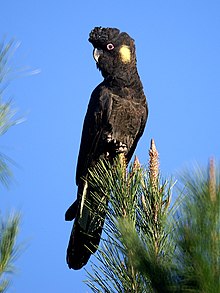| Yellow-tailed black cockatoo | |
|---|---|

| |
| A male in Wamboin, NSW, Australia | |
| Scientific classification | |
| Domain: | Eukaryota |
| Kingdom: | Animalia |
| Phylum: | Chordata |
| Class: | Aves |
| Order: | Psittaciformes |
| Family: | Cacatuidae |
| Genus: | Zanda |
| Species: | Z. funerea
|
| Binomial name | |
| Zanda funerea (Shaw, 1794)
| |
| Subspecies | |
|
Z. f. funerea | |

| |
| Yellow-tailed black cockatoo range:[3] Z. f. funerea in red Z. f. xanthanota in green | |
| Synonyms | |
| |
The yellow-tailed black cockatoo (Zanda funerea) is a large cockatoo native to the south-east of Australia measuring 55–65 cm (22–26 in) in length. It has a short crest on the top of its head. Its plumage is mostly brownish black and it has prominent yellow cheek patches and a yellow tail band. The body feathers are edged with yellow giving a scalloped appearance. The adult male has a black beak and pinkish-red eye-rings, and the female has a bone-coloured beak and grey eye-rings. In flight, yellow-tailed black cockatoos flap deeply and slowly, with a peculiar heavy fluid motion. Their loud, wailing calls carry for long distances. The yellow-tailed black cockatoo is found in temperate forests and forested areas across south and central eastern Queensland to southeastern South Australia, including a very small population persisting in the Eyre Peninsula.[4] Two subspecies are recognised, although Tasmanian and southern mainland populations of the southern subspecies xanthanotus may be distinct enough from each other to bring the total to three. Birds of subspecies funereus (Queensland to eastern Victoria) have longer wings and tails and darker plumage overall, while those of xanthanotus (western Victoria, South Australia and Tasmania) have more prominent scalloping. The subspecies whiteae is found south of Victoria to the East of South Australia and is smaller in size.
The yellow-tailed black cockatoo's diet primarily includes seeds of native and introduced plants while also feeding on wood-boring grubs.[5] They nest in large hollows high in old growth native trees (~ greater than 200 years old),[6] generally Eucalyptus regnans. Although they remain common throughout much of their range, fragmentation of habitat and loss of large trees suitable for nesting has caused population decline in Victoria and South Australia. Furthermore, the species may lose most of its mainland range due to climate change.[4] In some places yellow-tailed black cockatoos appear to have partially adapted to recent human alteration of landscape and they can often be seen in parts of urban Canberra, Sydney, Adelaide and Melbourne. The species is not commonly seen in aviculture, especially outside Australia. Like most parrots, it is protected by CITES, an international agreement that makes trade, export, and import of listed wild-caught species illegal.
- ^ BirdLife International (2016). "Zanda funerea". IUCN Red List of Threatened Species. 2016: e.T22684739A93044615. doi:10.2305/IUCN.UK.2016-3.RLTS.T22684739A93044615.en. Retrieved 13 November 2021.
- ^ See text – this is the name given to birds of South Australia and Western Victoria if Tasmanian and southern mainland birds are considered separate subspecies. This division is not generally accepted.
- ^ Cite error: The named reference
Forshaw (2006). plate 1.was invoked but never defined (see the help page). - ^ a b Amin, Rahil J.; Buettel, JessieC.; Fielding, Matthew W.; Vaughan, Peter M.; Brook, Barry W. (12 July 2021). "Hot, unpredictable weather interacts with land use to restrict the distribution of the Yellow-tailed Black-Cockatoo". Emu - Austral Ornithology. 121 (4): 323–332. Bibcode:2021EmuAO.121..323A. doi:10.1080/01584197.2021.1952083. ISSN 0158-4197. S2CID 237827331.
- ^ Cite error: The named reference
hig66was invoked but never defined (see the help page). - ^ Cite error: The named reference
:1was invoked but never defined (see the help page).
